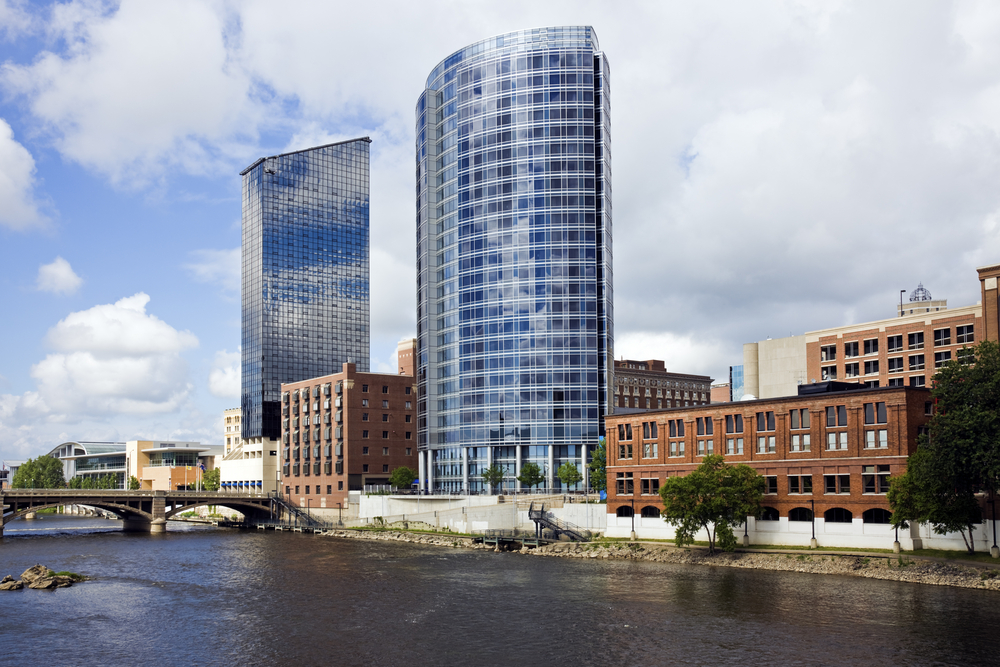U.S. Cities With the Most Stable Construction Jobs [2021 Edition]
As with many industries, the construction industry experienced major setbacks in the early days of the COVID-19 pandemic. Construction projects across the U.S. stopped, and employment in the industry fell by 14% from March 2020 to April 2020. While the industry has since rebounded, in part due to a nationwide housing boom and surging demand for home renovations, employment in the industry remains below pre-pandemic levels.
One issue is that construction firms are having a hard time filling jobs. According to the trade group Associated Builders and Contractors, the industry needed to hire nearly half a million more workers in 2021 to meet increased demand. Another issue is that the construction industry historically has had higher job turnover than other sectors of the economy. In 2019, before the pandemic began, the average quarterly turnover rate in the construction industry—defined as the ratio of separations to total employment—was 17.4%, or about two percentage points higher than the average across all industries, according to data from the U.S. Census Bureau.
Fortunately, job turnover rates in construction and in the economy as a whole have trended downward over the past several decades. In 1993 (the start of the Census Bureau’s Quarterly Workforce Indicators survey), the construction job turnover rate was over 27%, and the turnover rate across all industries was 19%. By 2019, turnover in the construction industry had fallen by 10 percentage points and the overall turnover rate had dropped to below 16%. Evidence suggests that broad declines in labor turnover can be explained by the aging workforce and a decrease in short-term employment spells resulting from better hiring and employment screening practices. However, the COVID-19 pandemic might reverse these trends, as more older Americans have chosen to retire early and employers have reported record numbers of quits in recent months.

FOR CONSTRUCTION PROFESSIONALS
In addition to builders risk insurance, construction firms should make sure they have adequate commercial car insurance for their work vehicles. Many insurance companies also offer dedicated truck insurance policies, which might provide more applicable coverage options depending on the business’s needs.
While the overall job turnover rate in the construction industry pre-pandemic was 17.4%, these rates vary geographically due to a variety of factors, including the age of the workforce, availability of other job opportunities, and local industry characteristics like seasonality and unionization rates. At the state level, Maryland and Hawaii reported the most stable construction jobs in the U.S., with construction job turnover rates of 13.1% and 13.2%, respectively. Other states with low turnover rates for construction workers included Massachusetts, Vermont, Wisconsin, and Virginia. Conversely, Wyoming, North Carolina, West Virginia, and North Dakota all had turnover rates at or above 24%.

To find the metropolitan areas with the most stable construction jobs, researchers at Construction Coverage analyzed employment data from the U.S. Census Bureau. The researchers ranked metro areas according to the pre-pandemic construction job turnover rate. Researchers also calculated the number of average quarterly hires, average quarterly separations, average quarterly total employment, and median earnings for construction industry workers. To improve relevance, only metropolitan areas with at least 100,000 people were included in the analysis. Additionally, metro areas were grouped by population size.
Here are the U.S. metros with the most stable construction jobs.

Large Metros With the Most Stable Construction Jobs

Photo Credit: jdross75 / Shutterstock
15. Nashville-Davidson–Murfreesboro–Franklin, TN
- Construction job turnover rate: 15.3%
- Average quarterly hires: 9,417
- Average quarterly separations: 8,724
- Average quarterly total employment: 57,198
- Median earnings for construction industry workers: $41,164

Photo Credit: Sean Pavone / Shutterstock
14. Providence-Warwick, RI-MA
- Construction job turnover rate: 15.3%
- Average quarterly hires: 6,251
- Average quarterly separations: 6,098
- Average quarterly total employment: 39,823
- Median earnings for construction industry workers: $51,468

Photo Credit: Rosamar / Shutterstock
13. Cincinnati, OH-KY-IN
- Construction job turnover rate: 15.2%
- Average quarterly hires: 8,948
- Average quarterly separations: 8,765
- Average quarterly total employment: 57,755
- Median earnings for construction industry workers: $44,207

Photo Credit: Zack Frank / Shutterstock
12. Columbus, OH
- Construction job turnover rate: 15.1%
- Average quarterly hires: 8,581
- Average quarterly separations: 7,961
- Average quarterly total employment: 52,881
- Median earnings for construction industry workers: $41,375

Photo Credit: Sean Pavone / Shutterstock
11. Dallas-Fort Worth-Arlington, TX
- Construction job turnover rate: 14.9%
- Average quarterly hires: 38,614
- Average quarterly separations: 36,789
- Average quarterly total employment: 246,719
- Median earnings for construction industry workers: $38,122

Photo Credit: f11photo / Shutterstock
10. San Antonio-New Braunfels, TX
- Construction job turnover rate: 14.9%
- Average quarterly hires: 10,885
- Average quarterly separations: 10,041
- Average quarterly total employment: 67,492
- Median earnings for construction industry workers: $35,360

Photo Credit: Sean Pavone / Shutterstock
9. Atlanta-Sandy Springs-Alpharetta, GA
- Construction job turnover rate: 14.7%
- Average quarterly hires: 23,121
- Average quarterly separations: 22,697
- Average quarterly total employment: 154,223
- Median earnings for construction industry workers: $38,015

Photo Credit: Jon Bilous / Shutterstock
8. Virginia Beach-Norfolk-Newport News, VA-NC
- Construction job turnover rate: 14.7%
- Average quarterly hires: 6,885
- Average quarterly separations: 6,818
- Average quarterly total employment: 46,495
- Median earnings for construction industry workers: $40,536

Photo Credit: Sean Pavone / Shutterstock
7. Austin-Round Rock-Georgetown, TX
- Construction job turnover rate: 14.3%
- Average quarterly hires: 12,912
- Average quarterly separations: 11,680
- Average quarterly total employment: 81,860
- Median earnings for construction industry workers: $39,270

Photo Credit: Sean Pavone / Shutterstock
6. Washington-Arlington-Alexandria, DC-VA-MD-WV
- Construction job turnover rate: 14.0%
- Average quarterly hires: 27,803
- Average quarterly separations: 27,174
- Average quarterly total employment: 194,637
- Median earnings for construction industry workers: $44,914

Photo Credit: Sean Pavone / Shutterstock
5. Richmond, VA
- Construction job turnover rate: 14.0%
- Average quarterly hires: 6,926
- Average quarterly separations: 6,875
- Average quarterly total employment: 48,958
- Median earnings for construction industry workers: $38,672

Photo Credit: Sean Pavone / Shutterstock
4. Boston-Cambridge-Newton, MA-NH
- Construction job turnover rate: 13.6%
- Average quarterly hires: 21,580
- Average quarterly separations: 20,556
- Average quarterly total employment: 151,539
- Median earnings for construction industry workers: $53,853

Photo Credit: Paul Brady Photography / Shutterstock
3. Milwaukee-Waukesha, WI
- Construction job turnover rate: 13.1%
- Average quarterly hires: 5,378
- Average quarterly separations: 5,112
- Average quarterly total employment: 39,166
- Median earnings for construction industry workers: $50,391

Photo Credit: Sean Pavone / Shutterstock
2. Baltimore-Columbia-Towson, MD
- Construction job turnover rate: 13.0%
- Average quarterly hires: 12,449
- Average quarterly separations: 12,173
- Average quarterly total employment: 93,303
- Median earnings for construction industry workers: $51,817

Photo Credit: Henryk Sadura / Shutterstock
1. Grand Rapids-Kentwood, MI
- Construction job turnover rate: 12.0%
- Average quarterly hires: 3,674
- Average quarterly separations: 3,513
- Average quarterly total employment: 29,282
- Median earnings for construction industry workers: $42,246
Detailed Findings & Methodology
To find the metropolitan areas with the most stable construction jobs, researchers at Construction Coverage analyzed employment data from the U.S. Census Bureau’s 2019 Longitudinal Employer-Household Dynamics (LEHD) Quarterly Workforce Indicators (QWI). The researchers ranked metro areas according to the construction job turnover rate. In the event of a tie, the metro with the lower number of average quarterly separations was ranked higher. Researchers also calculated the average quarterly hires, average quarterly total employment, and median earnings for construction industry workers. The job turnover rate for the year was calculated as the average quarterly job turnover rate—average quarterly separations divided by average quarterly employment.
To improve relevance, only metropolitan areas with at least 100,000 people were included in the analysis. Additionally, metro areas were grouped into the following cohorts based on population size:
- Small metros: 100,000-349,999
- Midsize metros: 350,000-999,999
- Large metros: 1,000,000 or more
Each company featured in our guides has been independently selected and reviewed by our research team. If you select one of these companies and click on a link, we may earn a commission.
By clicking on these links, you may be taken to one of our insurance partners. The specific company listed here may or may not be included in our partner’s network at this time.
